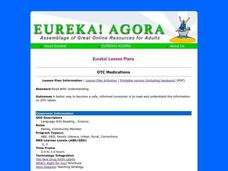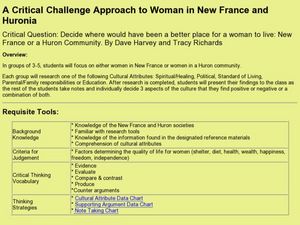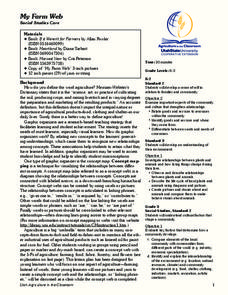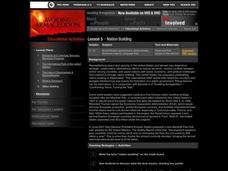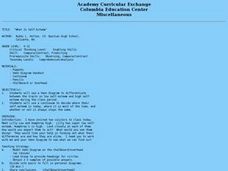Curated OER
Using Math Concepts to Collect and Document Specimens
Young scholars determine the length and width of leaf samples to the nearest millimeter and the circumference of trees. They participate in a discussion about the importance of collecting specimens carefully. They compile accurate...
Curated OER
OTC Medications
Students become aware of better ways to read and analyze the information provided on OTC labels. This concept is accompanied with the integration of technology, brochures and a Venn Diagram for illustration. They assess medical...
Curated OER
A Critical Challenge Approach to Woman in New France and Huronia
Students works in groups to study the lives of women in New France and Huron communities. In this French and Indian history lesson, student groups research cultural attributes that existed for women in New France and Huron communities....
Curated OER
My Farm Web
Students examine the role of agriculture in everyday life. In this agriculture lesson, students read books such as Harvest Year and identify products which from from the farm. Students fill in a word web using the knowledge they gained...
Curated OER
History of the Jews in England
Young scholars examine the history of Anti-Semitism in England. In this Jewish history lesson, students discuss the Pyramid of Hate and the Pyramid of Alliance as they discover a brief history of the Jews in England in the last 1000 years.
Curated OER
Nation Building
Learners explore the concept of nation building. In this diplomacy lesson, students research America's nation building efforts in Somalia, Haiti, the Balkans, Guatemala, Cuba, Vietnam, and Grenada. Learners share their findings and...
Curated OER
Chocolate Math
Learners practice solving math equations by analyzing chocolate recipe measurements. For this chocolate baking math lesson, students read about the Hershey factory and recipes used to create chocolate bars. Learners solve problems and...
Curated OER
Cupid’s Ambassador: The Cultural Impact of Chocolate
Students review a trip they made to the Hershey Museum. In this history of chocolate lesson, students determine the impact chocolate has made on cultures and create visual projects that feature their findings.
Curated OER
WHAT, IF ANYTHING, IS A ZEBRA?
Students read the essay, "What, If Anything, Is a Zebra?" following a teacher made reading guide. They investigate cladistics, shared derived characteristics, with further online research to enhance their study of evolution and...
Curated OER
Pseudogene Suite
High schoolers use Biology Workbench to explore DNA sequence data for the GULOP gene in humans, chimpanzees, orangutans, and crab-eating macaques and the beta globin gene and its pseduogene in humans, gorillas, and chimpanzees.
Curated OER
A Peek at the Past: Gradualism vs. Punctuated Equilibria
Students consider two sets of simulated fossils (caminalcules) that are provided as cutouts. They arrange them on two time scales. One set produces a visual example of gradualism, the other shows punctuated equilibria.
Curated OER
The Miracle Worker, by William Gibson
Tenth graders explore the resilience of the human spirit as it pertains to The Miracle Worker, by William Gibson. They also explore how people with disabilities can overcome great obstacles.
Curated OER
The Magic Hooey Stick
Students examine the use of a "magic hooey stick". They discover the concept of illusions and how science can reveal them. They answer discussion questions to end the lesson.
Curated OER
How's Your Horoscope?
Middle schoolers examine the concept of astrology. They compare their traits with those of standard astrological descriptions. They discuss their findings.
Curated OER
Why Cladistics?
Students explore how biological classification is intimately associated with evolution.
Curated OER
The World in 22 Minutes: Constructing a TV News Lineup
Students examine several newspapers to compare front pages, headlines, and photographs, experience role of news editor, define and discuss factors that go into news judgements, and arrange twenty-two minute news broadcast by selecting...
Curated OER
Bhutan, the Last Shangri-La: Sandwich Squash: How the Himalayas Were Formed
Middle schoolers create and record a model of mountain formation. They identify major mountain building formations. Students understand how the Himalaya Mountains were formed, why they are located near Bhutan, and why they are becoming...
Curated OER
SAY IT WITH DNA: Protein Synthesis Tutorial
Ninth graders explore protein synthesis. In this DNA instructional activity students complete a worksheet and a DNA lab activity.
Curated OER
Genetic Jewels: Building the DNA Model
Students construct segments of DNA to create a piece of jewelry. In this genetics activity students create a DNA sequence that they turn into something to wear.
Curated OER
What did T. rex taste like?
Students examine the three domains of life and explain that all living things share a common ancestor. In this paleontology lesson plan students are introduced to the process of illustrating evolutionary relationships.
Facing History and Ourselves
Interpreting the Works of Samuel Bak: Interruption
Students examine the works of Holocaust artist Samuel Bak. In this Holocaust lesson, students analyze and interpret the works of Bak that feature his first-hand childhood experience of the Holocaust.
Curated OER
Metric Conversions
Students translate a mathematical idea from one form to another. They compare and convert a given measurement to another unit within the same measurement system.
Curated OER
Just Stringing Along
Students learn the string instruments of the symphony orchestra and recognize their "relatives."
Curated OER
What Is Self-Esteem?
Students use a Venn diagram to differentiate between traits of low self-esteem and high self-esteem. They use a continuum to decide where their self-esteem is on a daily basis noting changes.
Other popular searches
- Amblyopia Teaching Strategies
- Visual Teaching Strategies
- Math Teaching Strategies
- Teaching Strategies Science



